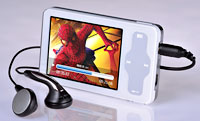 After consulting the well thumbed iPod design book, Chinese electronics manufacturers Meizu have rolled out their new Meizu Mini, a truly Lilliputian Personal Media Player.
After consulting the well thumbed iPod design book, Chinese electronics manufacturers Meizu have rolled out their new Meizu Mini, a truly Lilliputian Personal Media Player.
Despite its me-too design influences, the pocket-sized Meizu looks to be quite an interesting PMP device, sporting a large 2.4″ 260K-Color QVGA (320×240) TFT LCD screen, backed by up to 4GB of memory.
Meizu have also bolted on FM support (76Mhz-108Mhz) with up to 50 preset channels, and there’s a microphone socket for voice recording – pretty impressive for a device smaller than a credit card (79mm x 48.2mm x 10mm, weight 55g).
Media compatibility comes in the shape of support for MP3/WAV/OGG/WMA audio files, Xvid for video and BMP, JPG, GIF photo playback up to 1024×1024 resolution.
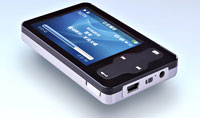 Other onboard gizmos include Synchronized Lyric Display, E-book, alarm clock, calculator, calendar and some (unspecified) games.
Other onboard gizmos include Synchronized Lyric Display, E-book, alarm clock, calculator, calendar and some (unspecified) games.
Battery life is claimed at a decent 20 hours of battery life for audio and 6 hours for video playback, with charging taking less than 2.5 hours.
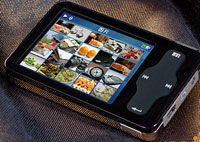 So far we’ve only seen Chinese language screen shots but the interface seems crisp and slick enough to us.
So far we’ve only seen Chinese language screen shots but the interface seems crisp and slick enough to us.
PC connectivity is via USB 2.0 with claimed transfer speeds of 8MB/s Read and 5MB/s Write.
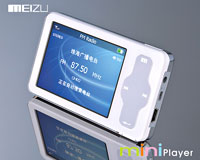 The player comes with a white or black finish and a metal back just like the – yep, you’ve guessed it – iPod.
The player comes with a white or black finish and a metal back just like the – yep, you’ve guessed it – iPod.
There’s multi-language support onboard covering English, Simplified Chinese, Traditional Chinese, Japanese and Korean languages, which suggest there’s a remote hope it may find its way into the UK (or at least be available by mail order). Or maybe not.
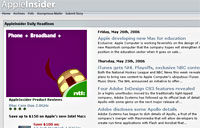 Apple’s attempt to identify the sources of leaked product information that appeared on Mac enthusiast websites has fallen flat on its face after a Californian court ruled that on-line reporters and bloggers are entitled to the same protections as traditional journalists.
Apple’s attempt to identify the sources of leaked product information that appeared on Mac enthusiast websites has fallen flat on its face after a Californian court ruled that on-line reporters and bloggers are entitled to the same protections as traditional journalists. The court was having none of it, with a unanimous ruling giving the three online publications protection under the shield law, as well as the constitutional privilege against disclosure of confidential sources.
The court was having none of it, with a unanimous ruling giving the three online publications protection under the shield law, as well as the constitutional privilege against disclosure of confidential sources.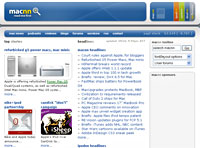 “The shield law is intended to protect the gathering and dissemination of news, and that is what petitioners did here,” added Justice Rushing.
“The shield law is intended to protect the gathering and dissemination of news, and that is what petitioners did here,” added Justice Rushing.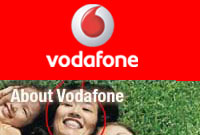 In the normal world, if you’d just discovered that your business had lost £14.9bn ($27.9bn) in a single year, you’d be blubbering into your laptop or heading to the pub to down a vat of Old Scrote’s Badger ale.
In the normal world, if you’d just discovered that your business had lost £14.9bn ($27.9bn) in a single year, you’d be blubbering into your laptop or heading to the pub to down a vat of Old Scrote’s Badger ale.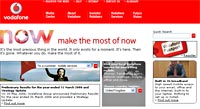 In the white-hot mobile phone segment, Vodafone continues to create growth in key markets such as Germany, Spain and the United States, despite being forced to scuttle out of Japan – selling the business for £8.9bn – after failing to make much of a mark in the country.
In the white-hot mobile phone segment, Vodafone continues to create growth in key markets such as Germany, Spain and the United States, despite being forced to scuttle out of Japan – selling the business for £8.9bn – after failing to make much of a mark in the country.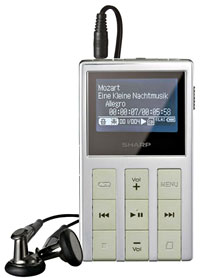 Details are still a bit sketchy on these shiny new fellas, but Sharp’s new range of flash based MP3 players sure look mighty purdy to our jaded eyes.
Details are still a bit sketchy on these shiny new fellas, but Sharp’s new range of flash based MP3 players sure look mighty purdy to our jaded eyes. As is de rigueur these days with (non Apple) MP3 players, there’s an FM tuner onboard with direct audio encoding – great for recording radio shows or capturing your mobile mumblings via the built in microphone
As is de rigueur these days with (non Apple) MP3 players, there’s an FM tuner onboard with direct audio encoding – great for recording radio shows or capturing your mobile mumblings via the built in microphone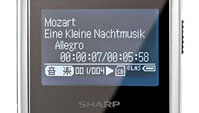 The measurements of the MP-B200 and MP-B300 are 49 x 87.6 x 8.9mm – pretty damn small, but positively bun-scoffing compared to 6.8mm thickness of the Apple iPod.
The measurements of the MP-B200 and MP-B300 are 49 x 87.6 x 8.9mm – pretty damn small, but positively bun-scoffing compared to 6.8mm thickness of the Apple iPod.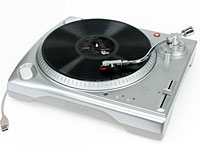 If you’ve got a big stack of top notch vinyl gathering dust at home, you may want to consider using this natty USB Turntable to record the platters that matter straight on to your desktop or laptop PC.
If you’ve got a big stack of top notch vinyl gathering dust at home, you may want to consider using this natty USB Turntable to record the platters that matter straight on to your desktop or laptop PC.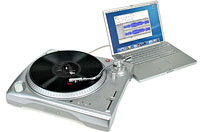 The turntable can also be hooked up to any home stereo with CD or auxiliary inputs so you can rock out to your old punk rock 45s after a night in the pub.
The turntable can also be hooked up to any home stereo with CD or auxiliary inputs so you can rock out to your old punk rock 45s after a night in the pub. Using your existing turntable
Using your existing turntable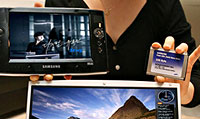 Samsung has announced the imminent release of the world’s first solid state laptops, in the shape of the Q1,an Ultra Mobile PC and the Q30-SSD, a 12.1-inch screen notebook PC
Samsung has announced the imminent release of the world’s first solid state laptops, in the shape of the Q1,an Ultra Mobile PC and the Q30-SSD, a 12.1-inch screen notebook PC The company also said that it was only selling the SSD laptops in South Korea to reduce the risks from teething problems.
The company also said that it was only selling the SSD laptops in South Korea to reduce the risks from teething problems.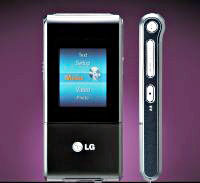 It may not have the swish designer lines of the iPod and the name may roll off the tongue as smoothly as a mouth full of dry nuts, but LG Electronics new MFJM53 MP3 player looks more than a bit useful.
It may not have the swish designer lines of the iPod and the name may roll off the tongue as smoothly as a mouth full of dry nuts, but LG Electronics new MFJM53 MP3 player looks more than a bit useful.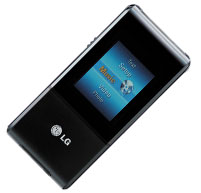 Although we like the look of this fella – the feature set particularly impresses – the lack of a scroll/clickwheel is going to seriously hamper its ability to challenge the dominance of the uber-iPod.
Although we like the look of this fella – the feature set particularly impresses – the lack of a scroll/clickwheel is going to seriously hamper its ability to challenge the dominance of the uber-iPod. At the W3C conference in Edinburgh today, in a move to get the mobile industry (and possibly more) to standardise on a single Web browser, Nokia has released the source code for the mobile Web browser it developed last year.
At the W3C conference in Edinburgh today, in a move to get the mobile industry (and possibly more) to standardise on a single Web browser, Nokia has released the source code for the mobile Web browser it developed last year.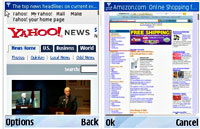 “We want to reduce the fragmentation currently in place in mobile browsing,” said Lee Epting, VP of Forum Nokia, Nokia’s software development support program.
“We want to reduce the fragmentation currently in place in mobile browsing,” said Lee Epting, VP of Forum Nokia, Nokia’s software development support program.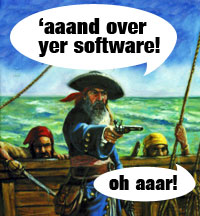 Over a third of all packaged software installed on PCs worldwide in 2005 was pirated, according to a study released by the Business Software Alliance (BSA), a trade group charged with fighting the use of unauthorised software.
Over a third of all packaged software installed on PCs worldwide in 2005 was pirated, according to a study released by the Business Software Alliance (BSA), a trade group charged with fighting the use of unauthorised software.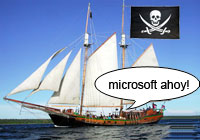 In fact, some have claimed that BSA’s accounting methods are so inaccurate that it amounts to scaremongering, especially when extrapolating figures from third world countries where just a few programs at full price would cost more than a citizen’s average annual income.
In fact, some have claimed that BSA’s accounting methods are so inaccurate that it amounts to scaremongering, especially when extrapolating figures from third world countries where just a few programs at full price would cost more than a citizen’s average annual income. In third place was France which notched up losses of $3.2 billion, accompanied by a piracy rate of 47 percent, while in Brit-land, 27 per cent of PC software used in the UK was claimed to be illegal.
In third place was France which notched up losses of $3.2 billion, accompanied by a piracy rate of 47 percent, while in Brit-land, 27 per cent of PC software used in the UK was claimed to be illegal.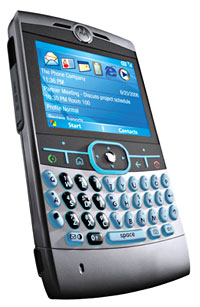 Months later than expected, Motorola’s new ‘Blackberry-killer’ smartphone, the Moto Q has finally been launched on the Verizon network in the US.
Months later than expected, Motorola’s new ‘Blackberry-killer’ smartphone, the Moto Q has finally been launched on the Verizon network in the US.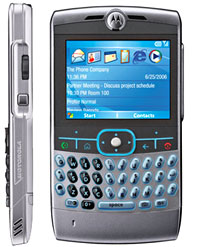 Shockley insisted that the Q is for people with a “life balance” (a what?) who want to use their phones to listen to music, take photos, record short videos and play games.
Shockley insisted that the Q is for people with a “life balance” (a what?) who want to use their phones to listen to music, take photos, record short videos and play games.